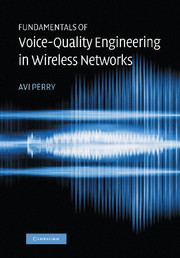Book contents
- Frontmatter
- Contents
- Preface
- List of abbreviations
- Introduction
- Part I Voice-quality foundations
- 1 An overview of voice-coding architectures in wireless communications
- 2 Quantitative assessment of voice quality
- Part II Applications
- Part III Wireless architectures
- Part IV A network operator's guide for selecting, appraising, and testing a VQS
- Part V Managing the network
- Part VI Afterthoughts and some fresh ideas
- Part VII Recordings
- Glossary of common voice-quality systems terminology
- Brief summary of echo cancelation and VQS major standards
- Brief summary of key voice-quality assessment standards
- Bibliography
- Index
1 - An overview of voice-coding architectures in wireless communications
Published online by Cambridge University Press: 24 May 2010
- Frontmatter
- Contents
- Preface
- List of abbreviations
- Introduction
- Part I Voice-quality foundations
- 1 An overview of voice-coding architectures in wireless communications
- 2 Quantitative assessment of voice quality
- Part II Applications
- Part III Wireless architectures
- Part IV A network operator's guide for selecting, appraising, and testing a VQS
- Part V Managing the network
- Part VI Afterthoughts and some fresh ideas
- Part VII Recordings
- Glossary of common voice-quality systems terminology
- Brief summary of echo cancelation and VQS major standards
- Brief summary of key voice-quality assessment standards
- Bibliography
- Index
Summary
Introduction
It must have happened to most of us. At some point through our lives we came across someone whom we deemed an “audio nut.” (Some of us may have even impersonated that one special character.) That singular person would not listen to music unless it was played back on an exceedingly pricey hi-fi system. He or she actually did hear a titanic disparity in sound quality between what we would be taking pleasure in on a regular basis and what he or she regarded as a minimum acceptable threshold.
In all probability, we might have adopted the same mind-set had we been accustomed to the same high-quality sound system. It is a familiar human condition – once a person lives through luxury, it grows to be incredibly hard getting used to less. How quickly have we forgotten the pleasure we took in watching black-and-white TV, listening to the Beatles on vinyl records, Frank Sinatra on AM radio, etc. But hey, we have experienced better sound quality and, thus, we refuse to look back.
Wireless telecommunications is entering its third generation (3G). Infancy started with analog communications. It developed through childhood in the form of GSM and CDMA, and has crossed the threshold to puberty with cdma2000 and W-CDMA – its third generation. Voice quality in wireless telecommunications is still young and looking up to adolescence, but technology has advanced appreciably, and most of us have been content with its voice performance.
- Type
- Chapter
- Information
- Publisher: Cambridge University PressPrint publication year: 2006



